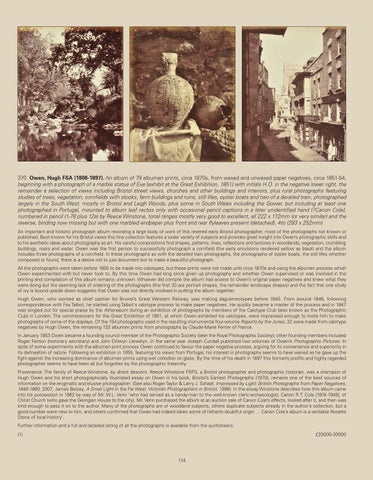DW101-131 Listing_Layout 1 30/03/2015 16:00 Page 114
370 Owen, Hugh FSA (1808-1897). An album of 79 albumen prints, circa 1870s, from waxed and unwaxed paper negatives, circa 1851-54, beginning with a photograph of a marble statue of Eve [exhibit at the Great Exhibition, 1851] with initials H.O. in the negative lower right, the remainder a selection of views including Bristol street views, churches and other buildings and interiors, plus rural photographs featuring studies of trees, vegetation, cornfields with stooks, farm buildings and ruins, still lifes, oyster boats and two of a derailed train, photographed largely in the South West, mostly in Bristol and Leigh Woods, plus some in South Wales including the Gower, but including at least one photographed in Portugal, mounted to album leaf rectos only with occasional pencil captions in a later unidentified hand [?Canon Cole], numbered in pencil (1-78 plus 12a) by Reece Winstone, tonal ranges mostly very good to excellent, all 222 x 172mm (or very similar) and the reverse, binding now missing but with one marbled endpaper plus front and rear flyleaves present (detached), 4to (283 x 252mm) An important and historic photograph album recording a large body of work of this revered early Bristol photographer, most of the photographs not known or published. Best-known for his Bristol views this fine collection features a wider variety of subjects and provides great insight into Owen’s photographic skills and to his aesthetic ideas about photography as art. His careful compositions find shapes, patterns, lines, reflections and textures in woodlands, vegetation, crumbling buildings, rocks and water. Owen was the first person to successfully photograph a cornfield (the early emulsions rendered yellow as black) and the album includes three photographs of a cornfield. In these photographs as with the derailed train photographs, the photographs of oyster boats, the still lifes whether composed or found, there is a desire not to just document but to make a beautiful photograph. All the photographs were taken before 1855 to be made into calotypes, but these prints were not made until circa 1870s and using the albumen process which Owen experimented with but never took to. By this time Owen had long since given up photography and whether Owen supervised or was involved in the printing and compilation of this album remains unknown. Whoever did compile the album had access to Owen’s original paper negatives and knew what they were doing but the seeming lack of ordering of the photographs (the first 33 are portrait shapes, the remainder landscape shapes) and the fact that one study of ivy is bound upside down suggests that Owen was not directly involved in putting the album together. Hugh Owen, who worked as chief cashier for Brunel’s Great Western Railway, was making daguerreotypes before 1845. From around 1846, following correspondence with Fox Talbot, he started using Talbot's calotype process to make paper negatives. He quickly became a master of the process and in 1847 was singled out for special praise by the Athenaeum during an exhibition of photographs by members of the Calotype Club (also known as the Photographic Club) in London. The commissioners for the Great Exhibition of 1851, at which Owen exhibited his calotypes, were impressed enough to invite him to make photographs of some of the displays. Of the 154 photographs used in the resulting monumental four-volume Reports by the Juries, 32 were made from calotype negatives by Hugh Owen, the remaining 132 albumen prints from photographs by Claude-Marie Ferrier of France. In January 1853 Owen became a founding council member of the Photographic Society (later the Royal Photographic Society); other founding members included Roger Fenton (honorary secretary) and John Dillwyn Llewelyn. In the same year Joseph Cundall published two volumes of Owen’s Photographic Pictures. In spite of some experiments with the albumen print process Owen continued to favour the paper negative process, arguing for its convenience and superiority in its delineation of nature. Following an exhibition in 1855, featuring his views from Portugal, his interest in photography seems to have waned as he gave up the fight against the increasing dominance of albumen prints using wet collodion on glass. By the time of his death in 1897 this formerly prolific and highly regarded photographer seems to have been all but forgotten by the photographic fraternity. Provenance: The family of Reece Winstone, by direct descent. Reece Winstone FRPS, a Bristol photographer and photographic historian, was a champion of Hugh Owen and his short photographically illustrated essay on Owen in his book, Bristol’s Earliest Photographs (1970), remains one of the best sources of information on the enigmatic and elusive photographer. (See also Roger Taylor & Larry J. Schaaf, Impressed by Light: British Photographs from Paper Negatives, 1840-1860, 2007; James Belsey, A Small Light in the Far West: Victorian Photographers in Bristol, 1996). In the essay Winstone describes how this album came into his possession in 1962 by way of Mr. W.L. Venn ‘who had served as a handy-man to the well-known cleric-archaeologist, Canon R.T. Cole [1874-1948], of Christ Church (who gave the Georgian House to the city). Mr. Venn purchased the album at an auction sale of Canon Cole’s effects, looked after it, and then was kind enough to pass it on to the author. Many of the photographs are of woodland subjects, others duplicate subjects already in the author’s collection, but a good number were new to him, and others confirmed that Owen had indeed taken some of hitherto doubtful origin … Canon Cole’s album is a veritable Rosetta Stone of local history’. Further information and a full and detailed listing of all the photographs is available from the auctioneers. (1)
£20000-30000
114
